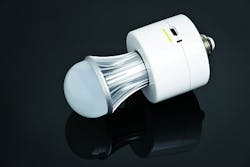Wireless Environment announces battery-backed LED lamp socket for emergency lighting
Startup specialty-lighting manufacturer Wireless Environment is using Lightfair International to launch the SwitchSense Bulb Adaptor that delivers a novel approach to emergency lighting. Designed for use with LED or compact fluorescent (CFL) replacement lamps, the adaptor can power lamps with a standard Edison base with batteries that are activated in the event of power failure to a building.
Emergency lighting is a complicated problem, especially in commercial buildings. For safety, such a building must have some type of lighting than can continue to operate in the case of power failure. Traditionally, buildings have installed dedicated emergency lighting, but increasingly low-power LED sources are enabling new approaches to the challenge.
In a public-venue applications, for instance, we covered how dimmable LEDs enable the requisite emergency lighting in London's Wembley Arena to also be a part of the house lighting system. For industrial applications, Dialight is able to power its SafeSite stainless-steel LED linear luminaire with an integrated 3.6V NiMH battery. It's the efficiency and dimmability of LED sources that have enabled such products and applications.
Wireless Environment is taking a broader view of the problem and planning to use the ubiquitous A-lamp along with the SwitchSense socket to provide emergency lighting. Most every commercial, or residential, building has Edison-based sockets readily available. The sockets can be installed with a conventional lamp in many types of fixtures, including the downlight implementation pictured nearby.
The main advantages of SwitchSense are that no new wiring is required to implement the emergency function and that the socket can be readily used with LED or CFL lamps. With more power-hungry incandescent lighting, the battery-backed adaptor wouldn’t supply emergency lighting for the required duration. But with LED or CFL lamps, emergency lights can last for as long as three hours.
Still, the designers of the adapter faced a bigger challenge than simply building a socket that included batteries. The SwitchSense product, as the name implies, must detect the difference between a light switched being turned off and a building losing power. Indeed, the company said that an open light switch will not trigger the socket, but after a power failure you can still control the lamp, while on battery power, with a wall switch.
Wireless Environment said it will ship SwitchSense in the fourth quarter of this year. The company's prior products include Mr Beams motion-sensing lights and ReadyBright Power Outage Lights intended for residential applications.






